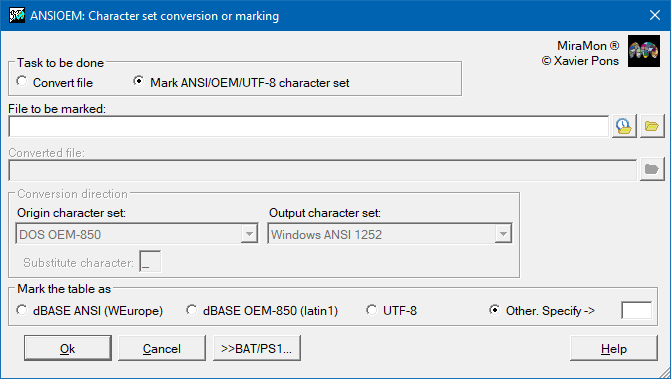| Presentation and options | Dialog box of the application |
| Examples | Syntax |
Because of the high diversity of characters existing in the different languages of the world, of the necessity to write down special symbols, and also due to the own computer science history, different sets of characters have been used in different countries and under different operating systems. Consequently, it is usual to find strange characters, for example when reading with a plain text editor under a Windows environment (such as notepad), or a text created with a plain text editor from another operating system, such as EDIT MS-DOS previous editor.
This problem can also be found in databases, where there are text fields that have been created using one of the several available character sets. In particular, when working with DBF format databases, there is an internal mark that, if it is activated (value greater than zero), it indicates with which set of characters has the text been written, so it is possible to interpretate it correctly.
This program has some options:
Many characters are convertible between different sets; for example either the OEM-850 set from MS-DOS, the ANSI 1252 and UTF-8 set from Windows have both all upper-case and lower-case accentuated characters. However, some characters only exist in one of the character sets; for example the Trade Mark symbol (TM), that in the ANSI 1252 set can be represented as a single character, has no representation in the OEM-850 set. In these last cases, conversion is not possible and an arbitrary substitute character is needed. This character will show us those characters that have no representation in the output character set.
Warning: Do not convert a file that is not a plain text or a DBF; otherwise its contents will be corrupted. Examples of plain text files are MiraMon's REL and MMM, TXT files, BAT files, etc.
Notes:
Some possible marks for ANSI in DBF tables are:
'ascii ANSI' 87 (0x57) (dBASE)
'WEurope ANSI' 88 (0x58) (dBASE) [program default]
'Spanish ANSI' 89 (0x59) (dBASE)
'FoxPro ANSI' 3 (0x03) (FoxPro)
To mark a table in agreement with one of these sets the decimal numerical value has to be indicated (for example 3 for FoxPro ANSI). MiraMon and MiraDades support all these marks.
Some possible marks for OEM-850 DBF tables are:
'dbDUTCH2 dBASENLDcp850' 10 (0x0A) (dBASE)
'dbFRENCH2 dBASEFRAcp850' 14 (0x0E) (dBASE)
'dbFRENCHCAN2 dBASEFRCcp850' 29 (0x1D) (dBASE)
'dbGERMAN2 dBASEDEUcp850' 16 (0x10) (dBASE)
'dbITALIAN2 dBASEITAcp850' 18 (0x12) (dBASE)
'dbPORTUGUESE2 dBASEPTBcp850' 37 (0x25) (dBASE)
'dbSPANISH2 dBASEESPcp850' 20 (0x14) (dBASE) [default]
'dbSWEDISH2 dBASESVEcp850' 22 (0x16) (dBASE)
'dbUK2 dBASEENGcp850' 26 (0x1A) (dBASE)
'dbUS2 dBASEENUcp850' 55 (0x37) (dBASE)
'FoxPro OEM-850' 2 (0x02) (FoxPro)
To mark a table in agreement with one of these sets the decimal numerical value has to be indicated (for example 14 for FRENCH2). MiraMon and MiraDades support all these marks.
 |
| ANSIOEM dialog box. |
ANSIOEM C:\COPIES\README.TXT D:\README.TXT 1 ANSIOEM C:\COPIES\README.TXT D:\README.TXT 1 ANSIOEM C:\BASES\COUNTRY.DBF A:\COUNTRY 3 ANSIOEM C:\BASES\MUNICIP ANSI ANSIOEM C:\BASES\MUNICIP 5 ANSIOEM C:\BASES\COMAR.DBF A:\COMAR_EN_UTF8.DBF 5 |
| Examples of ANSIOEM. |